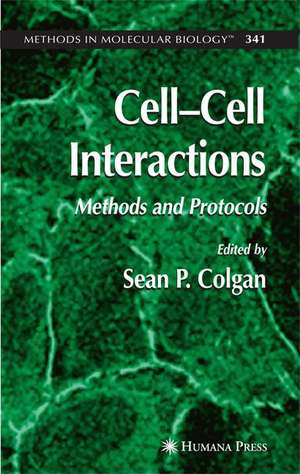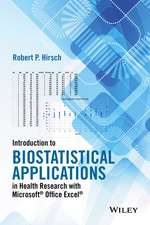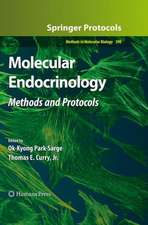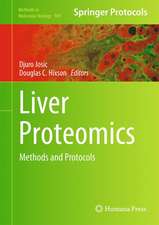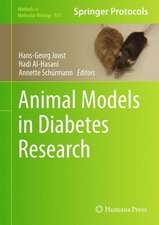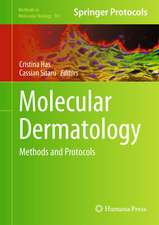Cell'Cell Interactions: Methods and Protocols: Methods in Molecular Biology, cartea 341
Editat de Sean P. Colganen Limba Engleză Hardback – 21 apr 2006
| Toate formatele și edițiile | Preț | Express |
|---|---|---|
| Paperback (1) | 715.19 lei 6-8 săpt. | |
| Humana Press Inc. – 19 noi 2010 | 715.19 lei 6-8 săpt. | |
| Hardback (1) | 723.21 lei 6-8 săpt. | |
| Humana Press Inc. – 21 apr 2006 | 723.21 lei 6-8 săpt. |
Din seria Methods in Molecular Biology
- 9%
 Preț: 791.59 lei
Preț: 791.59 lei - 23%
 Preț: 598.56 lei
Preț: 598.56 lei - 20%
 Preț: 882.95 lei
Preț: 882.95 lei -
 Preț: 252.04 lei
Preț: 252.04 lei - 5%
 Preț: 802.69 lei
Preț: 802.69 lei - 5%
 Preț: 729.61 lei
Preț: 729.61 lei - 5%
 Preț: 731.43 lei
Preț: 731.43 lei - 5%
 Preț: 741.30 lei
Preț: 741.30 lei - 5%
 Preț: 747.16 lei
Preț: 747.16 lei - 15%
 Preț: 663.45 lei
Preț: 663.45 lei - 18%
 Preț: 1025.34 lei
Preț: 1025.34 lei - 5%
 Preț: 734.57 lei
Preț: 734.57 lei - 18%
 Preț: 914.20 lei
Preț: 914.20 lei - 15%
 Preț: 664.61 lei
Preț: 664.61 lei - 15%
 Preț: 654.12 lei
Preț: 654.12 lei - 18%
 Preț: 1414.74 lei
Preț: 1414.74 lei - 5%
 Preț: 742.60 lei
Preț: 742.60 lei - 20%
 Preț: 821.63 lei
Preț: 821.63 lei - 18%
 Preț: 972.30 lei
Preț: 972.30 lei - 15%
 Preț: 660.49 lei
Preț: 660.49 lei - 5%
 Preț: 738.41 lei
Preț: 738.41 lei - 18%
 Preț: 984.92 lei
Preț: 984.92 lei - 5%
 Preț: 733.29 lei
Preț: 733.29 lei -
 Preț: 392.58 lei
Preț: 392.58 lei - 5%
 Preț: 746.26 lei
Preț: 746.26 lei - 18%
 Preț: 962.66 lei
Preț: 962.66 lei - 23%
 Preț: 860.21 lei
Preț: 860.21 lei - 15%
 Preț: 652.64 lei
Preț: 652.64 lei - 5%
 Preț: 1055.50 lei
Preț: 1055.50 lei - 23%
 Preț: 883.85 lei
Preț: 883.85 lei - 19%
 Preț: 491.88 lei
Preț: 491.88 lei - 5%
 Preț: 1038.84 lei
Preț: 1038.84 lei - 5%
 Preț: 524.15 lei
Preț: 524.15 lei - 18%
 Preț: 2122.34 lei
Preț: 2122.34 lei - 5%
 Preț: 1299.23 lei
Preț: 1299.23 lei - 5%
 Preț: 1339.10 lei
Preț: 1339.10 lei - 18%
 Preț: 1390.26 lei
Preț: 1390.26 lei - 18%
 Preț: 1395.63 lei
Preț: 1395.63 lei - 18%
 Preț: 1129.65 lei
Preț: 1129.65 lei - 18%
 Preț: 1408.26 lei
Preț: 1408.26 lei - 18%
 Preț: 1124.92 lei
Preț: 1124.92 lei - 18%
 Preț: 966.27 lei
Preț: 966.27 lei - 5%
 Preț: 1299.99 lei
Preț: 1299.99 lei - 5%
 Preț: 1108.51 lei
Preț: 1108.51 lei - 5%
 Preț: 983.72 lei
Preț: 983.72 lei - 5%
 Preț: 728.16 lei
Preț: 728.16 lei - 18%
 Preț: 1118.62 lei
Preț: 1118.62 lei - 18%
 Preț: 955.25 lei
Preț: 955.25 lei - 5%
 Preț: 1035.60 lei
Preț: 1035.60 lei - 18%
 Preț: 1400.35 lei
Preț: 1400.35 lei
Preț: 723.21 lei
Preț vechi: 761.27 lei
-5% Nou
Puncte Express: 1085
Preț estimativ în valută:
138.40€ • 144.31$ • 115.03£
138.40€ • 144.31$ • 115.03£
Carte tipărită la comandă
Livrare economică 21 martie-04 aprilie
Preluare comenzi: 021 569.72.76
Specificații
ISBN-13: 9781588295231
ISBN-10: 1588295230
Pagini: 308
Ilustrații: XIV, 286 p.
Dimensiuni: 155 x 235 x 24 mm
Greutate: 0.6 kg
Ediția:2006
Editura: Humana Press Inc.
Colecția Humana
Seria Methods in Molecular Biology
Locul publicării:Totowa, NJ, United States
ISBN-10: 1588295230
Pagini: 308
Ilustrații: XIV, 286 p.
Dimensiuni: 155 x 235 x 24 mm
Greutate: 0.6 kg
Ediția:2006
Editura: Humana Press Inc.
Colecția Humana
Seria Methods in Molecular Biology
Locul publicării:Totowa, NJ, United States
Public țintă
ResearchCuprins
Blood-Brain Barrier and Cell-Cell Interactions: Methods for Establishing In Vitro Models of the Blood-Brain Barrier and Transport Measurements.- Interactions of Intestinal Epithelial Cells With Bacteria and Immune Cells: Methods to Characterize Microflora and Functional Consequences.- The Role of Junctional Adhesion Molecules in Interactions Between Vascular Cells.- Cell-Cell Interactions on Solid Matrices.- Cell-Cell Interactions in the Kidney: Inducible Expression of Mutant G Protein ?-Subunits in Madin-Darby Canine Kidney Cells for Studies of Epithelial Cell Junction Structure and Function.- Nucleotide Metabolism and Cell-Cell Interactions.- Analysis of Mammalian Sperm-Egg Membrane Interactions During In Vitro Fertilization.- Collagen Gel Contraction Assay.- Methods to Assess Tissue Permeability.- Bacterial–Bacterial Cell Interactions in Biofilms: Detection of Polysaccharide Intercellular Adhesins by Blotting and Confocal Microscopy.- A Biochemical Method for Tracking Cholera Toxin Transport From Plasma Membrane to Golgi and Endoplasmic Reticulum.- Isolation and Culture of Murine Heart and Lung Endothelial Cells for In Vitro Model Systems.- Expression Cloning of Signaling Proteins Regulated by Cell Adhesion.- Assays for the Calcium Sensitivity of Desmosomes.- Tight Junctions and Cell–Cell Interactions.- Simultaneous Immunofluorescence Detection of Cadherin and ?-Catenin in Mouse Tissue Sections.- In Vitro Neutrophil Transepithelial Migration.- The Blot Rolling Assay: A Method for Identifying Adhesion Molecules Mediating Binding Under Shear Conditions.- Cell-Cell Interaction in the Transcellular Biosynthesis of Novel ?-3-Derived Lipid Mediators.- Isolation and Analysis of Lipid Rafts in Cell–Cell Interactions.
Textul de pe ultima copertă
The use of directed cell models to study the manner in which two or more cells interact has revolutionized our understanding of protein-protein interactions in a complex milieu and has provided an invaluable platform for the identification of new molecules. In Cell-Cell Interactions: Methods and Protocols, highly skilled experts in the development and utilization of cell-cell interaction assays describe in detail their best methods-based approaches, both in vitro and in vivo, for uncovering cellular interactions at the molecular level. The protocols cover a diverse set of cell-cell interaction models in both normal and pathological states, are readily adaptable to nearly any cell type and organ system, and include primary data and outcome analysis. In addition, the protocols follow the successful Methods in Molecular Biology™ series format, each offering step-by-step laboratory instructions, an introduction outlining the principles behind the technique, lists of the necessary equipment and reagents, and tips on troubleshooting and avoiding known pitfalls.
Insightful to beginners and inspiring to seasoned professionals, Cell-Cell Interactions: Methods and Protocols provides the cutting-edge and versatile laboratory tools needed to gain a basic understanding of cell-cell interactions.
Insightful to beginners and inspiring to seasoned professionals, Cell-Cell Interactions: Methods and Protocols provides the cutting-edge and versatile laboratory tools needed to gain a basic understanding of cell-cell interactions.
Caracteristici
Includes supplementary material: sn.pub/extras
